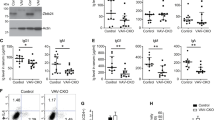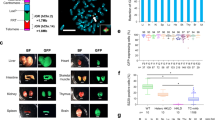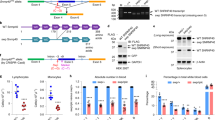Abstract
MAJOR histocompatibility complex (MHC) class I molecules are integral membrane proteins present on virtually all vertebrate cells and consist of a heterodimer between the highly polymorphic α-chain and the β2microglobulin (β2-m) protein of relative molecular mass 12,000 (ref. 1). These cell-surface molecules play a pivotal part in the recognition of antigens, the cytotoxic response of T cells, and the induction of self tolerance1,2. It is possible, however, that the function of MHC class I molecules is not restricted to the immune system, but extends to a wide variety of biological reactions including cell–cell interactions. For example, MHC class I molecules seem to be associated with various cell-surface proteins, including the receptors for insulin, epidermal growth factor, luteinizing hormone and the β-adrenergic receptor3–6. In mice, class I molecules are secreted in the urine and act as highly specific olfactory cues which influence mating preference7, 8. The β2-m protein has also been identified as the smaller component of the Fc receptor in neonatal intestinal cells9, and it has been suggested that the protein induces collagenase in fibrob-lasts10. Cells lacking β2-m are deficient in the expression of MHC class I molecules, indicating that the association with β2-m is crucial for the transport of MHC class I molecules to the cell surface1. The most direct means of unravelling the many biological functions of β2-mis to create a mutant mouse with a defective β2-mgene. We have now used the technique of homologous recombination to disrupt the β2-mgene. We report here that introduction of a targeting vector into embryonic stem cells resulted in β2-mgene disruption with high frequency. Chimaeric mice derived from blastocysts injected with mutant embryonic stem cell clones transmit the mutant allele to their offspring.
This is a preview of subscription content, access via your institution
Access options
Subscribe to this journal
Receive 51 print issues and online access
$199.00 per year
only $3.90 per issue
Buy this article
- Purchase on Springer Link
- Instant access to full article PDF
Prices may be subject to local taxes which are calculated during checkout
Similar content being viewed by others
References
Klein, J., Juretic, A., Baxevanis, C. N. & Nagy, Z. A. Nature 291, 455–460 (1981).
Zinkernagel, R. M. & Doherty, P. C. Adv. Immun. 27, 51–117 (1979).
Fehlmann, M. et al. Proc. natn. Acad. Sci. U.S.A. 82, 8634–8637 (1985).
Due, C., Simonsen, M. & Olsson, L. Proc. natn. Acad. Sci. U.S.A. 83, 6007–6011 (1986).
Schreiber, A. B., Schlessinger, J. & Edidin, M. J. cell. Biol. 98, 725–731 (1984).
Solano, A. R. et al. Proc. natn. Acad. Sci. U.S.A. 85, 5087–5091 (1988).
Singh, P. B., Brown, R. E. & Roser, B. Nature 327, 161–164 (1987).
Yamazaki, K. et al. Science 240, 1331–1332 (1988).
Simister, N. E. & Mostov, K. E. Nature 337, 184–187 (1989).
Brinckerhoff, C. E., Mitchell, T. I., Karmilowicz, M. J., Kluve-Beckerman, B. & Benson, M. D. Science 243, 655–657 (1989).
Robertson, E., Bradley, A., Kuehn, M. & Evans, M. Nature 323, 445–448 (1986).
Gossler, A., Doetschman, T., Korn, R., Serfling, E. & Kemler, R. Proc. natn. Acad. Sci. U.S.A. 83, 9065–9069 (1986).
Thomas, K. R. & Capecchi, M. R. Cell 51, 503–512 (1987).
Mansour, S. L., Thomas, K. R. & Capecchi, M. R. Nature 336, 348–352 (1988).
Doetschman, T., Maeda, N. & Smithies, O. Proc. natn. Acad. Sci. U.S.A. 85, 8583–8587 (1988).
Joyner, A. L., Skarnes, W. C. & Rossant, J. Nature 338, 153–156 (1989).
Zimmer, A. & Gruss, P. Nature 338, 150–153 (1989).
Thompson, S., Clarke, A. R., Pow, A. M., Hooper, M. L. & Melton, D. W. Cell 56, 313–321 (1989).
Rudnicki, M. A. & McBurney, M. W. in Teratocarcinomas and Embryonic Stem Cells (ed. Robertson, E. J.) 19–49 (IRL, Oxford, 1987).
Potter, T. A., Frankel, W., Zeff, R. A. & Rajan, T. V. J. Immun. 138, 1270–1274 (1987).
Croce, C. M. et al. Proc. natn. Acad. Sci. U.S.A. 78, 5754–5758 (1981).
Bradley, A., Evans, M., Kaufman, M. & Roberston, E. Nature 309, 255–256 (1984).
Sawicki, J. A., Magnuson, T. & Epstein, C. J. Nature 294, 450–451 (1981).
William, R. L. et al. Nature 336, 684–587 (1988).
Johnson, R. et al. Science 245, 1234–1236 (1989).
Author information
Authors and Affiliations
Rights and permissions
About this article
Cite this article
Zijlstra, M., Li, E., Sajjadi, F. et al. Germ-line transmission of a disrupted β2microglobulin gene produced by homologous recombination in embryonic stem cells. Nature 342, 435–438 (1989). https://doi.org/10.1038/342435a0
Received:
Accepted:
Published:
Issue Date:
DOI: https://doi.org/10.1038/342435a0
This article is cited by
-
Covalent TCR-peptide-MHC interactions induce T cell activation and redirect T cell fate in the thymus
Nature Communications (2022)
-
Know Your Model: A brief history of making mutant mouse genetic models
Lab Animal (2021)
-
Abl family tyrosine kinases govern IgG extravasation in the skin in a murine pemphigus model
Nature Communications (2019)
-
Deconstructing and reconstructing the mouse and human early embryo
Nature Cell Biology (2018)
-
Non-pathogenic tissue-resident CD8+ T cells uniquely accumulate in the brains of lupus-prone mice
Scientific Reports (2017)
Comments
By submitting a comment you agree to abide by our Terms and Community Guidelines. If you find something abusive or that does not comply with our terms or guidelines please flag it as inappropriate.



